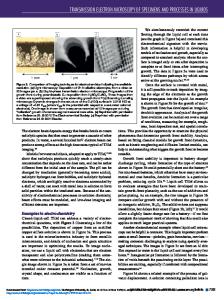Observation of materials processes in liquids by electron microscopy
- PDF / 531,782 Bytes
- 7 Pages / 585 x 783 pts Page_size
- 16 Downloads / 360 Views
Introduction Recent advances in aberration-corrected scanning/transmission electron microscopy (S/TEM) have made imaging and spectroscopy with atomic-scale resolution routine.1–3 Concurrent with this progress is an effort to image materials at or near realistic reaction conditions. This is exemplified by in situ TEM observations of nanostructured material growth (such as silicon nanowire growth),4,5 solid–gas reactions during catalysis (such as gold nanoparticles in carbon monoxide),6–8 and materials deformation (such as nanoindentation of aluminum).9 Such results have required both the development of dedicated microscopes that can handle gas environments around the sample (environmental TEM) and the ability to manipulate and fabricate materials at the nanoscale. The recent development of “liquid cells” for imaging liquid samples provides unique additional opportunities for understanding structure and chemical or physical processes involving materials synthesis and device functionality. Liquid-cell microscopy has been used to examine nucleation, growth, coalescence, and motion of nanoparticles in solution;10–13 electrochemically driven processes such as deposition, corrosion, and the motion of ions;14–17 bubble formation;18,19 biomineralization;20 soft materials;21,22 and whole cells and macromolecular complexes in aqueous environments.23–25 Its high spatial and temporal resolution, as well as its compatibility with established analytical microscopy techniques, means that liquid-cell
electron microscopy can provide information that cannot be obtained using other methods. Electron microscopy of liquids has developed in two directions, using closed and open liquid cells. These approaches have advantages and challenges for each material and process under study. Here, we describe these techniques and illustrate their use through two important applications. Observation of particle nucleation and growth, achieved in closed liquid cells, provides wide opportunities for answering key questions related to liquid-phase synthesis and materials design. Observation of electrochemical processes, which can be achieved in both open and closed cells, illuminates the different capabilities of the two approaches. Based on these and other examples, we assess the future role that electron microscopy of liquid samples will play in an increasingly diverse set of areas in materials science.
Design considerations for electron microscopy of liquids Closed cells Water, the most interesting of liquids, has traditionally been incompatible with the vacuum constraints of electron microscopy because of its high vapor pressure. Liquids with high vapor pressure can be separated from the microscope vacuum in a closed liquid cell. This is an enclosure that is filled, sealed, and loaded into the microscope on a sample holder.
Chong-Min Wang, Pacific Northwest National Laboratory, USA; [email protected] Hong-Gang Liao, Materials Sciences Division, Lawrence Berkeley National Laboratory, USA; [email protected] Frances M. Ross, IBM T.J. Watson Research











